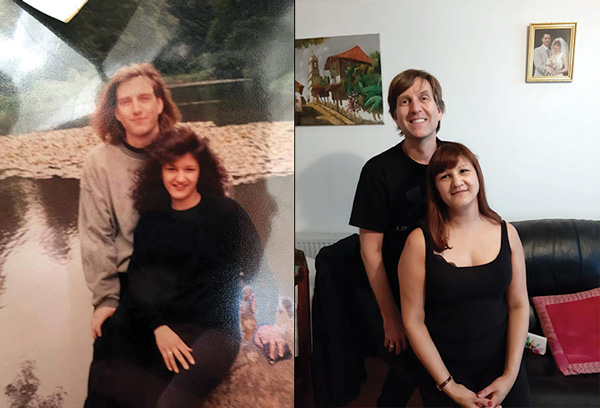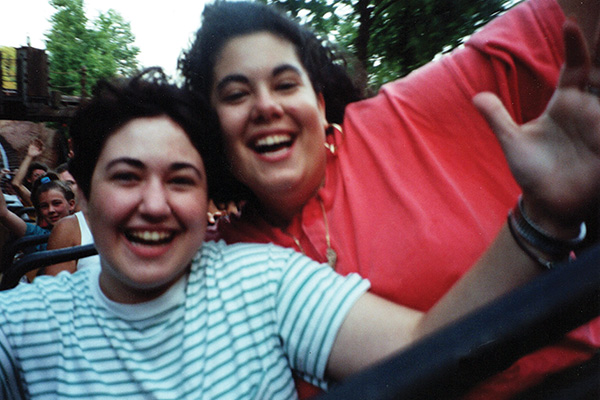Having a Pen Pal Is Good Medicine
When Steven Kamla responded to an advertisement for a pen pal in the back of Teen Magazine in the early ’80s, he could not have known then that he’d be laying the foundation for what would become a lifelong friendship. Nor could he have imagined that pen-to-paper communication, nearly four decades later, would be rendered a lost art thanks to marvels known as email and Snapchat. But that’s what happened to Kamla, a teen from Wisconsin who is now a 52-year-old hair stylist in San Francisco. He estimates that he and his pen pal, Mohini Mistry, who lives outside of London, England, have exchanged close to a thousand letters. The two have met several dozen times too, but despite advanced technology, they are sticking to their old ways.
“I’ve never thought of emailing her as that was never our relationship,” says Kamla. “I didn’t even have her email until six months ago, and we are still adamant about continuing to write.”
As teens, the duo talked about school and family and gushed over clothes and their favorite music. They even sent magazine pictures and badges depicting their favorite bands (Duran Duran, Wham!, Soft Cell, Michael Jackson). As they grew older, their friendship deepened, and they navigated topics such as college and jobs, health issues, and even personal hurdles such as when Mistry’s parents, both Hindu, planned to arrange her marriage. Mistry wrote to Kamla, revealing that she planned to tell them she wanted to live her life and be with someone she loved. She’s been married to her English husband, Garry, for 31 years now, and Kamla, along with Mistry’s parents, attended the wedding.

“I had my friends and work colleagues, but I always wrote Steven more about my feelings,” Mistry says. “Even though he was in America, he understood me more than anyone and he has remained a constant in my life.”
Also thinking of the people who shaped her life was Nancy Davis Kho, the author of The Thank-You Project. In 2016, the year she turned 50, Davis Kho set out on a pen-and-paper gratitude journey and wrote 50 thank-you letters to friends, coworkers, teachers, exes, doctors, and family members, including her father, who framed the letter and hung it above his desk. Davis Kho’s father passed away unexpectedly later that year, but knowing that she’d put her words of love and thanks down on paper for him provided comfort. “So much of our communication is digital now, and nothing sticks around. But by putting something into the physical artifact of a letter, there’s a permanence that allows you and your recipient the opportunity to really savor the sentiments within.”
There are plenty of studies on the positive benefits of writing, including one by social psychologist James W. Pennebaker, a pioneer on the subject and a professor at the University of Texas, Austin. He’s also the author of Opening Up: The Healing Power of Expressing Emotion and Writing to Heal, in which he details evidence that expressive writing heals physically and emotionally. Davis Kho found this to be absolutely true. By virtue of seeking things to include in her letters, she says she enhanced her positive recall bias — the ability to notice positive things rather than negative things first — and fostered a greater sense of forgiveness in cases where she’d held on to old hurts and resentments.
“What has surprised me most about writing letters is how much differently I express myself and how much deeper I am able to go.”
“The thank-you letters made those things recede into the background, and I think they strengthened my sense of connection and community,” she says. “People who received my letters certainly understand better how much I care for them, and they treat me accordingly.”
With, on average, 2.26 billion people using Facebook, WhatsApp, Instagram, and Messenger each day to communicate, it’s easy to shoot off meaningless words, angry or otherwise, without a second thought, and forget about them just as quickly. For Kamla, letter writing has prompted a journey of self-discovery. “What has surprised me most about writing letters is how much differently I express myself and how much deeper I am able to go,” he says. “I can slow down and take the time to think about what I want to say. It’s therapeutic in a way. And knowing I will have Mistry’s full attention when she’s reading makes me more thoughtful about my words.”
For our hyperconnected culture, the concept of “losing touch” is a hard one to grasp. But during the pre-computer, pre-cheap phone plan world, letters were the instant messages of their day, and a link to friends far away. This was true for Raffi Darrow, 44, of St. Petersburg, Florida, and her best friend Rivki Yellin. The two met in San Jose, California, and spent first and second grade together before Yellin and her family moved to Staten Island. They spent the next 15 years writing back and forth, sending Scooby-Doo stickers and recounting stories of boyfriends and movies, and later weddings and children. Darrow says they don’t write letters anymore, opting for the ease of phone calls and instant photos, but the letters were the glue that kept their friendship together.

Something else today’s rapid-fire technology can’t deliver and the instant-gratification culture misses out on? The sweet sensation of anticipation. “Waiting was unbearably exciting. There was nothing like opening the mailbox and seeing that physical letter. It’s hard to explain this to my kids now,” Darrow says. “I felt important and loved every time I got a letter from Rivki, and I know she felt the same way.”
Darrow still has all her letters, as does Mistry. And Davis Kho made copies of the ones she sent knowing that one day, they will be signposts of her younger days.
“It will be so lovely to look back at your correspondence from the vantage point of an older age and be reminded of who you were, and who and what mattered to you.”
This article is featured in the May/June 2020 issue of The Saturday Evening Post. Subscribe to the magazine for more art, inspiring stories, fiction, humor, and features from our archives.
Featured image: Shutterstock
Do Passive-Aggressive Signs Work?
You’ve seen them before, and maybe you’ve even written one (or printed it off with cute, non-threatening clipart to emphasize your good faith): the signs and notes that serve as totally casual reminders for people to behave themselves, essentially. Some are passive-aggressive (“Unattended children will be given espresso and a free puppy”), and some are just aggressive (“Since your MOTHER does not live at this office, please clean up after yourself!”).
While dining at a local establishment, I noticed a handwritten sign on the trash receptacle that read “Please be a SUPERSTAR and don’t throw our trays away!” Of course, everyone knows to avoid tossing plastic trays into the garbage at restaurants, but this sign was implying that someone had been doing just that. Is the sign-maker trying to flatter me into good behavior? I thought. But most of all I wondered: Does it work?
These signs are universally ugly stains on otherwise pleasant spaces, and the behavior advocated by most of them is common sense: watch your children, refill the copier’s paper tray, don’t piss on the toilet seat. In fact, it could be hypothesized that reminding people to do these things — and therefore suggesting that they might not otherwise do them — fosters resentment and possible retaliation. What’s a Type A personality to do?
Adamaris Mendoza is a psychotherapist and communication coach, and she’s been noticing what she calls “common sense signs” more and more. Between restaurants, bathrooms, and taxicabs, Mendoza believes these signs are so ubiquitous that people just don’t see them anymore. The passive-aggressiveness (or whimsical irony, if you like) of some sign-makers is, Mendoza says, a communication strategy similar to that of a lot of social media: capture people’s attention and convince them to do something. There is also a catharsis for the sign-maker because they’ve said their piece, even if it’s ineffective. And Mendoza believes that it probably will be, because “a sign isn’t going to change someone’s values.”
A psychological explanation for whether or not these bite-sized bits of persuasion are effective has been in the works for more than half a century. The reactance theory, proposed by Jack W. Brehm in 1966, describes the phenomenon of “an unpleasant motivational arousal that emerges when people experience a threat to or loss of their free behaviors.” Brehm and many others have studied how and why people rebel against persuasion, demands, and advice for years, and the research has been directed at safe sex and anti-smoking campaigns, political reforms, and water conservation. It can explain why Adam bit into the forbidden fruit and, possibly, why your coworker still leaves their dirty coffee mug on the counter next to your carefully crafted sign advising the opposite.
Attempts to persuade, especially if they convey a restriction on a person’s behaviors, can be met with the boomerang effect, the unintended consequence of a listener — or sign viewer — to think and do the exact opposite of what is being conveyed. This all depends on the message, of course. In a study about sun safety, when the message was framed as a loss (“When you do not use sun protection you will pay costs.”) instead of a gain (“When you use sun protection you will gain benefits.”), participants showed significantly stronger perceptions of threat to their freedom. That threat positively correlated with feelings of anger. Other studies have shown that messaging can work against itself by using controlling language (words like should, ought, must, and need) instead of less forceful terms (consider, can, could, and may). The more a message threatens people’s ability to decide how to behave, the more they are wont to ignore it.
“As a general rule, any communication that generates anger in the target person at the sender or the sender’s message is less likely to be persuasive,” says Timothy Levine, the Distinguished Professor and Chair of Communications Studies at University of Alabama-Birmingham. “It’s hard to sort out ineffective from actual backfire, but being likable is a better bet for persuasion.”
It would be difficult to argue that a sign (especially a wordy, confrontational one) stands much of a chance against our own instincts. So what are they good for? Release, perhaps. The moment of hanging a piquant, articulate message after weeks or months of annoyance, one can imagine, would be an emotional purge. But if the goal is to instill actual behavior change, psychology experts recommend that we avoid robbing people of their own sense of volition while making our requests, perhaps by implying choice. If this isn’t possible, it might not be worth making a sign at all.
I wondered about the “SUPERSTAR” sign and its maker: who were they? Did it work? Was it worth it? So I gave the restaurant a call. Many months had passed, but the employee who answered the phone remembered the sign, although it had since been taken down. He said it was created by a coworker who just liked to draw and make signs while she was bored. He didn’t even remember their having any problem with trays being thrown away. So did it work? “Yeah, maybe?” he said. “I think she just wanted to lighten the mood and create a fun atmosphere.” Basically, it wasn’t that deep.
On a recent return to the restaurant, I noticed a new handwritten sign taped next to the drink machine: “Do NOT order a water cup and fill it with soda! We WILL catch you, and we WILL embarrass you!” Although the threat of humiliation is typically a weak deterrent for me, a shameless writer, I obeyed the warning, because I am also a superstar.